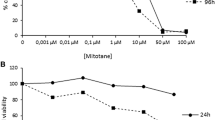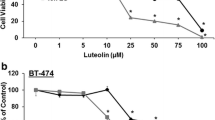Abstract
Using the Boyden chamber invasion assay, the effect of 1α,25-dihydroxyvitamin D3 [1α,25(OH)2D3] on the invasiveness of the highly invasive, oestrogen receptor-negative human breast cancer cell line MDA-MB-231 was examined. The MDA-MB-231 cells were shown to contain high-affinity receptors for 1α,25(OH)2D3 with a Kd of 1.5 × 10−11 M. When the cells were treated with 1α,25(OH)2D3 for 4 days before the assay was performed, a dose-dependent inhibition of their invasive potential was demonstrated. Fifty per cent inhibition of invasion was obtained with a concentration of 13 pM of 1α,25(OH)2D3. However, when the cells were treated for only 6 h during the assay, no inhibitory effect was seen. The process of migration was also affected by treatment with 1α,25(OH)2D3 for 4 days, although the inhibition was not of the same magnitude as seen for the invasion. Fifty per cent inhibition of migration occurred at a concentration of 3.2 nM of 1α,25(OH)2D3 (250 times higher than in the invasion assay). Inhibition of invasion and migration was not due to the known anti-proliferative effect of 1α,25(OH)2D3, as no growth reduction could be demonstrated with treatment up to 5 days. Based on the present investigation it can therefore be concluded that 1α,25(OH)2D3 is able to inhibit tumour cell invasiveness by a mechanism which is not exclusively based on its anti-proliferative and anti-migrative effects.
Similar content being viewed by others
References
Liotta LA, 1986, Tumor invasion and metastasis-role of the extracellular matrix. Rhoads Memorial Award Lecture.Cancer Res,46, 1–7.
Abe J, Nakano T, Nishii Y,et al. 1991, A novel D3 analog, 22-oxa-1,25-dihydroxyvitamin D3, inhibits the growth of human breast cancerin vitro andin vivo without causing hypercalcemia.Endocrinology,129, 832–7.
Chouvet C, Vicard E, Devonec M and Saez S, 1986, 1,25-Dihydroxyvitamin D3 inhibitory effect on the growth of two human breast cancer cell lines (MCF-7, BT-20).J Steroid Biochem,24, 373–6.
Colston K, Colston MJ and Feldman D, 1981, 1,25-Dihydroxyvitamin D3 and malignant melanoma: the presence of receptors and inhibition of cell growth in culture.Endocrinology,108, 1083–6.
Colston KW, Chander SK, MacKay AG and Coombes RC, 1992, Effects of synthetic vitamin D analogues on breast cancer cell proliferationin vivo andin vitro.Biochem Pharmacol,44, 693–702.
Dokoh S, Donaldson CA, Marion SL, Pike JW and Haussler MR, 1983, The ovary: a target organ for 1,25-dihydroxyvitamin D3.Endocrinology,112, 200–5.
Dokoh S, Donaldson CA and Haussler MR, 1984, Influence of 1,25-dihydroxyvitamin D3 on cultured osteogenic sarcoma cells: correlation with the 1,25-dihydroxyvitamin D3 receptor.Cancer Res,44, 2103–9.
Eisman JA, Koga M, Sutherland RL, Barkla DH and Tutton PJM, 1989, 1,25-Dihydroxyvitamin D3 and the regulation of human cancer cell replication.Soc Expl Biol Med,191, 221–6.
Frampton RJ, Omond SA and Eisman JA, 1983, Inhibition of human cancer cell growth by 1,25-dihydroxyvitamin D3 metabolites.Cancer Res,43, 4443–7.
Iino Y, Noritaka S, Maemura M,et al. 1992, 1α,25(OH)2D3, hypercalcaemia, and growth suppression of 7,12-dimethylbenz[a]anthracene-induced rat mammary tumors.Breast Cancer Res Treatment,22, 133–40.
Binderup L and Bramm E, 1988, Effects of a novel vitamin D analogue MC 903 on cell proliferation and differentiationin vitro and on calcium metabolismin vivo. Biochem Pharmacol,37, 889–95.
Koeffler HP, Hirji K, Itri L and the Southern California Leukemia Group, 1985, 1,25-Dihydroxyvitamin D3:in vivo andin vitro effects on human preleukemic and leukemic cells.Cancer Treatment Reports,69, 1399–407.
Norman AW, Zhou JY, Henry HL, Uskokovic MR and Koeffler HP, 1990, Structure-function studies on analogues of 1α,25-hydroxyvitamin D3: differential effects on leukemic cell growth, differentiation, and intestinal calcium absorption.Cancer Res,50, 6857–64.
Okabe-Kado J, Honma Y, Kasukabe T and Hozumi M, 1992, Synthesis of active metabolite(s) from 1α-hydroxyvitamin D3 by human monocytic leukemia cells.FEBS Lett,309, 399–401.
Studzinski GP, Bhandal AK and Brelvi ZS, 1985, Cell cycle sensitivity of HL-60 cells to the differentiation-inducing effects of 1α,dihydroxyvitamin D3.Cancer Res,45, 3898–905.
Colston K, Berger U and Coombes RC, 1989, Possible role for vitamin D in controlling breast cancer cell proliferation.Lancet,28, 188–91.
Colston K, Mackay AG, Chander S, Binderup L and Coombes RC, 1991, Novel vitamin D analogues suppress tumour growthin vivo. In: Norman AW, Bouillon R and Thomasset M, eds.Vitamin D: gene regulation, structure-function analysis and clinical application, pp. 465–6. Berlin: W. de Gruyter.
Honma Y, Hozumi M, Abe E,et al. 1983, 1α,25-Hydroxyvitamin D3 and 1α-hydroxyvitamin D3 prolong survival time in mice inoculated with myeloid leukemia cells.Proc Natl Acad Sci, USA,80, 201–4.
Oikawa T, Yoshida Y, Shimamura M,et al. 1991, Antitumor effect of 22-oxa-1α,25-dihydroxyvitamin D3, a potent angiogenesis inhibitor, on rat mammary tumors induced by 7,12-dimethylbenz[a]anthracene.Anti-cancer Drugs,2, 475–80.
Sato K, Takusagawa K, Asoo N and Konno K, 1982, Antitumour effect of 1α-hydroxyvitamin D3.Tohoku J Exp Med,138, 445–6.
Sato T, Takusagawa K, Asoo N and Konno K, 1984, Effect of 1α-hydroxyvitamin D3 on metastasis of rat ascites hepatoma K-231.Br J Cancer,50, 123–5.
Berger U, McClelland RA, Wilson P,et al. 1991, Immunocytochemical determination of estrogen receptor, progesterone receptor, and 1,25-dihydroxyvitamin D3 receptor in breast cancer and relationship to prognosis.Cancer Res,51, 239–44.
Thompson EW, Paik S, Brünner N, 1992, Association of increased basement membrane invasiveness with absence of estrogen receptor and expression of vimentin in human breast cancer cell lines.J Cell Phys,150, 534–44.
Eisman JA, Suva LJ and Martin TJ, 1986, Significance of 1,25-dihydroxyvitamin D3 receptor in primary breast cancers.Cancer Res,46, 5406–8.
Hall RE, Lee CSL, Alexander IE,et al. 1990, Steroid hormone receptor gene expression in human breast cancer cells: inverse relationship between oestrogen and glucocorticoid receptor messenger RNA levels.Int J Cancer,46, 1081–7.
Brünner N, Thompson EW, Spang-Thomsen M,et al. 1992,LacZ transduced human breast cancer xenografts as anin vivo model for the study of invasion and metastasis.Eur J Cancer,28A, 1989–95.
Price JE, Polyzos A, Zhang RD and Daniels LM, 1990, Tumorigenicity and metastasis of human breast carcinoma cell lines in nude mice.Cancer Res,50, 717–21.
Brinkley BR, Beall PT, Wible LJ,et al. 1980, Variations in cell form and cytoskeleton in human breast carcinoma cellsin vitro.Cancer Res,40, 3118–29.
Frandsen TL, Boysen BB, Jirus S,et al. 1992,In vitro andin vivo assays for the study of human cancer cell invasion and metastasis.Fibrinolysis,6, supplement 4, 71–6.
Cho YL, Christensen C, Saunders DE,et al. 1991, Combined effects of 1,25-dihydroxyvitamin D3 and platinum drugs on the growth of MCF-7 cells.Cancer Res,51, 2848–53.
Bower M, Colston KW, Stein RC,et al. 1991, Topical calcipotriol treatment in advanced breast cancer.Lancet,337, 701–2.
Findley DM, Michelangeli VP, Eisman JA,et al. 1980, Calcitonin and 1,25-dihydroxyvitamin D3 receptors in human breast cancer cell lines.Cancer Res,40, 4764–7.
Eisman JA, Martin TJ, MacIntyre I and Moseley JM, 1979, 1,25-Dihydroxyvitamin D receptors in breast cancer cells.Lancet,29, 1335–6.
Minghetti PP and Norman AW, 1988, 1,25(OH)2-Vitamin D3 receptors: gene regulation and genetic circuitry.FASEB J,2, 3043–53.
Binderup L, 1992, Immunological properties of vitamin D analogues and metabolites.Biochem Pharmacol,43, 1885–92.
Norman AW, Nemere I, Zhou LX,et al. 1992, 1,25(OH)2-Vitamin D3, a steroid hormone that produces biological effects via both genomic and non-genomic pathways.J Steroid Biochem Molec Biol,41, 231–40.
Barsky SH, Rao CN, Hyams D and Liotta LA, 1984, Characterization of a laminin receptor from human breast carcinoma tissue.Breast Cancer Res Treatment,4, 181–8.
Castronovo V, Taraboletti G, Liotta LA and Sobel ME, 1989, Modulation of laminin receptor expression by estrogen and progestins in human breast cancer cell lines.J Natl Cancer Inst,81, 781–8.
Horand Hand P, Thor A, Schlom J, Rao CN and Liotta L, 1985, Expression of laminin receptor in normal and carcinomatous human tissues as defined by a monoclonal antibody.Cancer Res,45, 2713–19.
Koli K and Keski-Oja J, 1993, Vitamin D3 and calcipotriol decrease extracellular plasminogen activator activity in cultured keratinocytes.J Invest Dermatol,101, 706–12.
Ossowski L, 1992, Invasion of connective tissue by human carcinoma cell lines: requirement for urokinase, urokinase receptor, and interstitial collagenase.Cancer Res,52, 6754–60.
Pyke C, Græm N, Ralfkiær E,et al. 1993, Receptor for urokinase is present in tumor-associated macrophages in ductal breast carcinoma.Cancer Res,53, 1911–15.
Liotta LA, Tryggvason K, Garbisa S,et al. 1980, Metastatic potential correlates with enzymatic degradation of basement membrane collagen.Nature,284, 67–8.
Nakajima M, Welch DR, Belloni PN and Nicholson GL, 1987, Degradation of basement membrane type IV collagen and lung subendothelial matrix by rat mammary carcinoma cell clones of differing metastatic potentials.Cancer Res,47, 4869–76.
Nakajima M, Lotan D, Baig MM,et al. 1989, Inhibition by retinoic acid of type IV collagenolysis and invasion through reconstituted basement membrane by metastatic rat mammary adenocarcinoma cells.Cancer Res,49, 1698–706.
Bar-Shavit Z, Kahn AJ, Stone KR,et al. 1986, Reversibility of vitamin D-induced human leukemia cell-line maturation.Endocrinology,118, 679–86.
Carlberg C, Bendik I, Wyss A,et al. 1993, Two nuclear signalling pathways for vitamin D.Nature,361, 657–60.
Clarke R, Brünner N, Thompson EW,et al. 1989, The inter-relationships between ovarian-independent growth, tumorigenicity, invasiveness and antieostrogen resistance in the malignant progression of human breast cancer.J Endocr,122, 331–40.
Author information
Authors and Affiliations
Rights and permissions
About this article
Cite this article
Hansen, C.M., Frandsen, T.L., Brünner, N. et al. 1α,25-Dihydroxyvitamin D3 inhibits the invasive potential of human breast cancer cellsin vitro . Clin Exp Metast 12, 195–202 (1994). https://doi.org/10.1007/BF01753887
Received:
Accepted:
Issue Date:
DOI: https://doi.org/10.1007/BF01753887




